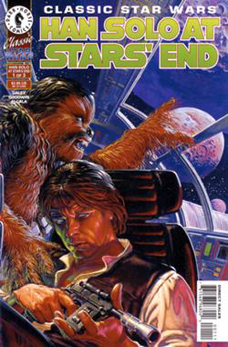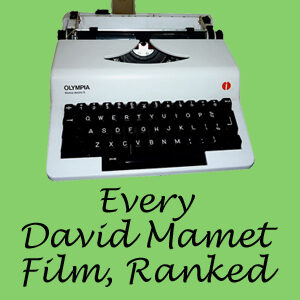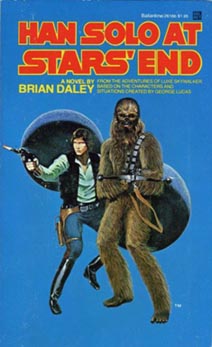In an interview with Star Wars Insider, Jeff Grubb (author of the new novel “Scourge,” which I’ll review in a future post), separates “Star Wars” novels into three categories: Jedi books, war books and “scum and villainy” books. That latter are his favorite, and I concur.
The earliest example from this category is Brian Daley’s “Han Solo at Stars’ End” (1979), which was only the second Expanded Universe novel, following “Splinter of the Mind’s Eye.” It was the first of three “Han Solo Adventures” novels that — along with the radio dramas — established Daley as a fan favorite.
When I think of Daley’s strengths, I think of his handling of Han Solo and Chewbacca’s friendship, the Millennium Falcon as a character in its own right, and the general adventurous freedom of a smugglers’ life (if he’d lived long enough to see it, Daley would’ve loved TV’s “Firefly”). Rereading “Stars’ End,” I was reminded of all the little details that feel right. He only had “A New Hope” to draw from, yet he intuitively understood how to play in George Lucas’ sandbox; almost nothing contradicts the EU as we know it today.
The one possibly apocryphal element that jumped out at me is on page 127 of the original paperback, where we’re told that Bollux — a droid in Han’s service during this trilogy — served “as a regimental commander during the Clone Wars.” We have yet to see any clunky droids of his design in Clone Wars stories, but even here, Daley correctly anticipated that the Clone Wars heavily involved droid soldiers.
Daley wisely invented the Corporate Sector so he could have a powerful governmental baddie to harass Han Solo without using the Empire, which he knew would be more strictly defined in Lucas’ films. Although one might guess from “A New Hope” that the Empire covers 100 percent of the galaxy, the EU has since established that there have always been pockets of the galaxy not enveloped by whatever the galactic government is; indeed, many authors have taken advantage of this, whether venturing into the underground of Hutt Space or telling stories of alien cultures on the edges of the galaxy.

Interestingly, in writer Archie Goodwin and artist Alfredo Alcala’s 1980 comic strip adaptation of “Stars’ End,” reprinted as a three-issue comic series in 1997 by Dark Horse, the Corporate Sector ships are drawn as Imperial ships. The big dreadnaughts become Star Destroyers and the IRD starfighters become TIE fighters. (Alcala also draws Z-95 Headhunters “wrong,” although it’s not his fault that they would later be redesigned as precursors to X-wing fighters.)
My guess is that Goodwin — who was also working during this time on the Marvel comic books, which didn’t shy away from using the Empire as a villain — decided that the Corporate Sector was a branch of the Empire, and he wanted to streamline the storytelling by using Imperial ship designs. Through the years, however, the EU has supported Daley’s vision as the Corporate Sector as an independent entity, thus rendering Alcala’s art apocryphal.

“Stars’ End” features one funny element that you’ll find in a lot of old sci-fi books: An underestimation of what future technology would be like. Blue Max is a boxy blue droid who fits inside Bollux’s chest plastron. It’s humorous to read passages about Chewbacca carrying Blue Max under an arm or Han slinging him over his shoulder with an extendable carrying strap, because Blue Max is — for all intents and purposes — a flash drive. Like so many of his contemporaries, Daley foresaw the future of computers, but just couldn’t envision miniaturization (although, admittedly, Blue Max is smaller than R2-D2, arguably an even clunkier computer).
The most striking scene in “Stars’ End” is when Han Solo discovers the traitor in his group (the book is largely structured like a dime-store mystery novel) and then mercilessly blasts him out of an airlock of the Falcon. I imagine the scene where Solo preemptively blows away Greedo in the cantina inspired Daley to pursue this darker side of Solo’s character. For whatever reason, Goodwin and Alcala rewrite this scene to have Solo do the same method of shooting through the table from below that he used on Greedo. Like in the original movie, at least, the bad guy doesn’t get off a stray shot.
If memory serves, the Han Solo trilogy picks up some steam with the second book, “Han Solo’s Revenge.” Still, “Han Solo at Stars’ End” holds up all these years later as a dirty, cranked-out space adventure that captures Han and Chewie’s life on the outskirts of the law.

